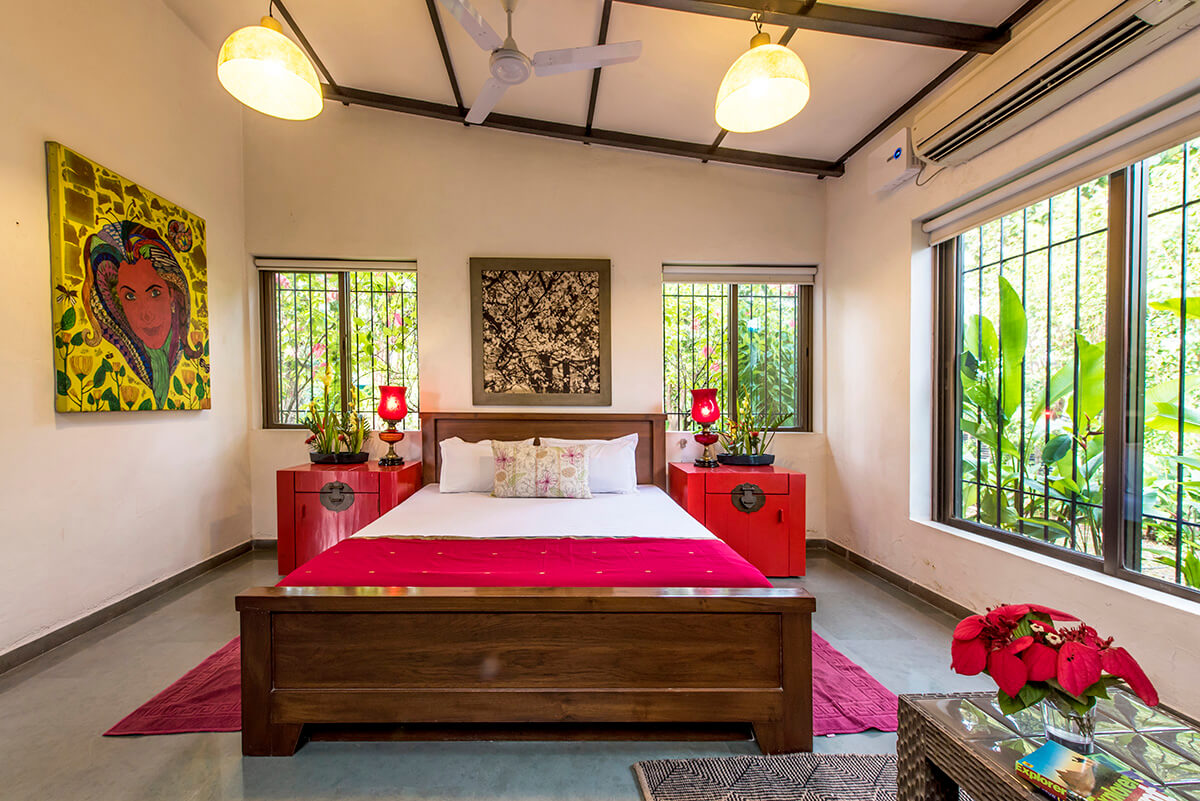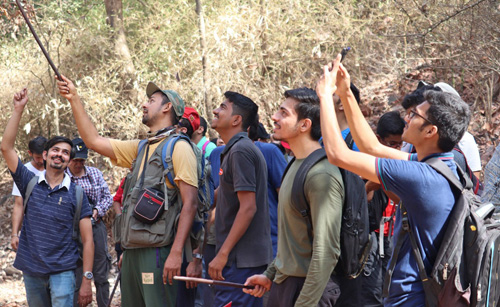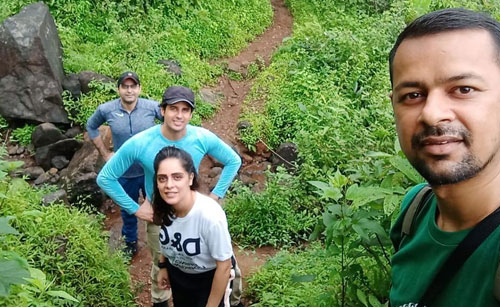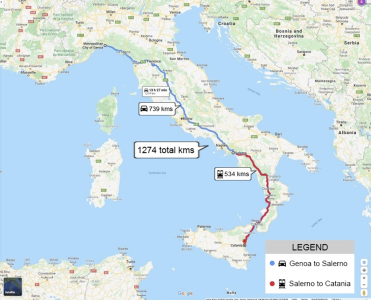Taking advantage of a Hindu festival of Holi – long weekend, I escaped the impending Indian Summer, to a cool paradise on earth called Nepal. While getting on the flight of the Nepal Airlines, I was intrigued by their logo of “Akash Bhairava” a sky form of a Bhairava (a Tantric form of Lord Shiva) and went into deep thought about the land I was just about to visit.

I was awakened from my thoughts by the light and uplifting atmosphere on the flight (compared to when one lands in Mumbai, it is completely opposite). One of passengers near-by kept ordering “Everest” beer and the poor hostess had to oblige though cautiously. Since it was my first visit to Nepal I was excited what lay ahead of me. I was excited to experience the joy of visiting a new country and culture. What I didn’t realise that it would be so familiar and yet so different from my own. Let the adventure begin!
 The logo of the Royal Nepal Airlines is an Akash Bhairav (a Tantric form of Lord Shiva). The myth, history and legend goes that a King Yalandar, the first King of the Kirata Kingdom in Nepal (1,500 B.C.) whose successors ruled Nepal for 31 generations or over 1,900 years, fought the war on the side of the Kauravas in the Mahabharata War. Seeing this as a losing proposition for the Pandavas, Krishna chopped his head off which came flying to Nepal, and established the “Akash” Bhairava, or the Bhairav of the air route.
The logo of the Royal Nepal Airlines is an Akash Bhairav (a Tantric form of Lord Shiva). The myth, history and legend goes that a King Yalandar, the first King of the Kirata Kingdom in Nepal (1,500 B.C.) whose successors ruled Nepal for 31 generations or over 1,900 years, fought the war on the side of the Kauravas in the Mahabharata War. Seeing this as a losing proposition for the Pandavas, Krishna chopped his head off which came flying to Nepal, and established the “Akash” Bhairava, or the Bhairav of the air route.
Below – Buddhist Monks feeding Bottles of Red Wine to the Bhairava Statue in Darbar Square, Kathmandu, Nepal while they chant mantras to please the deity. Kal-Bhairav is the fierce or Tantric form of Lord Shiva, the Hindu God of destruction.
| A rainy day when I arrived at the airport. The weather was amazingly cool during my entire trip. What strikes a visitor from India about Nepal is the comfortable feeling of not having left your country at all. Coming from India, Nepal feels like home, but little different. Little bit more oriental and exotic. Little less puritanical . And then mountain people somehow are so much better always than the people who live on the plains (I wonder why?). Thats the cherry on the cake for Nepal, a feature that no one can copy or replicate, no amount of money or infrastructure can make up for the hospitality, warm and friendliness of the people of this great, proud and free-spirited nation. |








Brief History
The British lost the war to the brave and fierce Gurkha warriors in 1814-16 (Anglo-Nepalese war). Seeing the bravery and fighting skills of the Gurkha army, Post the war they were inducted into the British Army. As long as the British were well supplied by Nepalese Gurkha soldiers, they kept their hands off Nepal. Just like animal sacrifices are given to gods in Nepal, the heads of the Gurkha soldiers were sacrificed to the British Gods in order to maintain peace. Only one Britisher was allowed to stay in Kathmandu, that too under strict surveillance.
Similarly, the Mughals were not able to capture these clever mountain people, and many of the Rajasthani Princes, who wanted to escape Muslim dominance of Hindu India, made their way to this Himalayan Kingdom. Till today the royal families in Nepal, trace their lineage to the Rajputs of Rajasthan. Since Nepal has never been colonised, neither did they have any Islamic influence, it made me wonder if they have been able to retain the Hindu culture in its original and intact form??

A traditional Khukri Knife of the Gurkha Warriors can be purchased anywhere in Nepal in various beautiful ornamental designs as souvenirs. A rum bottle with the same name when I went for Trout fishing near Pokhara.
If that were true, the Hindu culture must have been much more wilder, freer and sexually open, as many of the taboos and inhibitions that are present in Indian Hindu culture have come due to “Pardah” system of Islam or then the “Victorian” puritanical values. Ancient Hindu India must have been a much more “guilt free” society with regards to their attitude towards sex if one considers the few inhibitions that Hindu Nepali people would hold compared to Hindu Indian people.

Purple haze with live concert.
The night life of Kathmandu is surprisingly fantastic with night clubs, bars, restaurants open till wee hours of the morning. Purple Haze Rock Bar is one such place which plays live rock music. Even a thriving Metropolis like Mumbai with so many creative people doesn’t have half as cool a music scene as Kathmandu. Alcohol is easily available in Kathmandu in almost every store unlike India, where special license is required to be able to vend alcohol.
A gay bar in Kathmandu.
Kathmandu and neighbouring areas
The capital city of Kathmandu is thriving metropolis in the midst of gigantic valley. The snow capped mountains around could be seen many decades earlier, but now due to the pollution and increase in population it is impossible to see. The “Pahari” or “mountain people” name of Kathmandu comes from Kasthamandap temple, that stood in Durbar Square. In Sanskrit, Kastha (Sanskrit: काष्ठ) means “Wood” and Maṇḍapa (Sanskrit: मन्डप) means “Pavilion”.






The “Newari” people or the original inhabitants of Kathmandu, which primarily developed due to its geographical position through a trade link between Tibet and India, gave most of the culture now visible in present day Kathmandu including the wooden and brick architecture, the Living Goddess or “Kumari” etc. They are believed to be both Hindu and Buddhist at the same time. Straddling the fine-line between two important ancient religions, of two regions, both of which they served.






”Garudas and Nagas can be found everywhere in kathmandu starting from the airport. In the ancient history of Nepal, Kathmandu Valley was a huge lake in which many snakes lived, until it was drained out by Rishi Vipaswi Tathagat.”
China Aid given after the earth quake of 2015 to restore the Darbar Square Area.
The must visits in and around Kathmandu are the ancient cities of Bhaktapur and Patan each of which have their Durbar Square. Given as fiefdoms to prevent sibling rivalry, together with Kathmandu, they form the trinity of ancient cities of the valley. Many of the ancient monuments of Bhaktapur were heavily destroyed in the earthquake in 2015, except for the magnificient seven-story Lakshmi (Nyatapol Temple) temple. I read somewhere that there is an earthquake every 80 years in Nepal. The human loss caused by the recent earthquake was far less than the previous ones, so it is believed that another one is due soon.






Gallery – from visit to Bhaktapur, ancient town near Kathmandu, only a drive of about half hour from the city centre. The curd is very famous here. Also a local dish, like a Roti made from Dal with a fried egg stuck to it like a Frankie served with potatoes curry. The 7-storied Lakshmi Temple that withstood the earthquake.’
The Swayambhunath temple or stupa is an ancient Buddhist and Hindu shrine atop a hill, west of Kathmandu. It is also known as Monkey Temple. Swayambhu means “Self-Sprung”. This is one of the most holy places of pilgrimage for Buddhist and Hindus alike. It offers magnificent views of the Kathmandu Valley. The thousands of buddhist prayers flags swinging in the wind are whispering to us, reminding us of our mortal nature. The seamless activity of Hindu and Buddhist shrines in close proximity to each other reflect the attitude of the Newari people, the original settlers of Kathmandu and their equal belief towards both religions.
The sleeping Vishnu temple in Budhanilkantha towards the North of Kathmandu is also a must see. There were many Indian tourists here who come for pilgrimage. Though “Neel Kant” is normally a name for Lord Shiva in India, here it refers to Vishnu, “the old blue throated” God. This temple is recorded to be over 1,300 years old, and it was discovered when a local peasant was tilling the land, and the land started to bleed, only to uncover an ancient statue. The royalty of Nepal has been cursed that if they visit this shrine they will receive immediate death, and hence they stay away.

Sleeping Vishnu temple.
Of course no visit to Kathmandu is complete without a visit to the Pashupatinath temple, where Shiva is present in his form as a lover of all animals, my most favourite form of Shiva. There is also an NGO which serves stray dogs just outside the temple, how symbolic! One thing I felt with regards to Pashupati Nath is the non-commercial aspect of the temple compared to temples in India, which have been highly commercialised.

Also there was an ancient shrine of Snake Vasuki next to the main shrine. Vasuki is the “King of the Nagas” or Serpent Race that lived on earth much before the humans. All the knowledge that we humans have is from these ancient reptiles. When the humans were given earth to live upon, they complained the gods about their co-existing with this strange species (look who’s calling whom strange!) and the nagas readily sacrificed their lands, leaving for the patel-lok and naga-lok.
The old and sick snakes were left behind which are the ones we see now on earth. The entire valley of Kathmandu was under water where giant serpents lived till Goddess Manjushri with her sword created a gorge in the southern part of Kathmandu, Chovar, for the water to be drained out, thus making the valley habitable, as per the mythology.
”Large bathing areas at the entrance of Pashupatinath temple. The signature snow-lions outside the temple. Me with my host Sunita Shresta, an Newari family of Kathmandu. No photographs are allowed inside the temple area.”
I would highly recommend to stay at the Kantipur Temple house boutique hotel in the heart of Thamel area. It is an ancient palace that has been converted into a hotel. There is no television or air-conditioning in the room but it’s really not required. There is beautiful Newari Architecture in the hotel, of brick, stone and wooden panels and windows.









Pokhara and neighbouring areas
Just a short 25-minute flight from Kathmandu, for which I paid only Rs. 2,800 return ticket, one is in Pokhara a beautiful lake city in the laps of the most magnificent mountain ranges namely Annapurna and the Fish Tale mountain. Pokhara has many hotels, restaurants and becomes the base camp for many of the treks to the neighbouring areas.
Here one begins to get the real feel of Nepal, and the height and extremity of these mountain ranges that consist of this great country. I stayed in the Himalayan Front Hotel, which is a little far away from Pokhara Enroute to one peak called Sarangkot. The views from the hotel rooms especially at sunrise are magnificent but it is far away from the hustle and bustle of the main city.


I was awoken at 4 AM with the sound of a massive thunderbolt that rang through my bones. The entire hotel and bed shook loudly with it. It was a call from the Mountains to wake up and not waste any time sleeping our mortal lives away. My soul was stirred with the power of nature. In Nepal it is difficult to sleep till later in the morning. I was up at 5AM every day. There is harsh Sun at 7AM. No wonder they say that the energies in the mountains are best for spiritual advancement.
There is very beautiful Vindhyavasini temple just outside of Pokhara city. The idol was bought from India, but when they devotees took an overnight rest at this spot, next day they were not able to lift the idol back up again. They decided that the goddess had chosen her place and built a temple around the spot. It is very scenic spot on top of a hill with the most unusual flora and fauna growing around the temple. A must visit!







A most unusual looking mouse outside the Ganesh Temple. The signature snow lion which is found everywhere was adopted as a symbol of Shakyamuni Buddha in early Buddhism; it is also depicted as a vehicle for a number of Vajrayana deities such as Vaishravana and Manjushri, and the lion throne may be found in many nirmanakaya Buddha forms.








Trout farm near Pokhara.
A tiny mountainous nation stuck between two gigantic landmasses, two elephantine populations and two terribly ancient cultures of India and China. The nepalese are experts in the balancing act of life. That has become their way of life. But what I admire the most about them is that in spite of the great amount of poverty in this nation, the people are happy as they go about their daily chores. A proud and fierce people laden with dollops of self-respect, that is the average Nepali person.
A local trader in Pokhara, had a dream where he was asked to dig up at a certain point. There was a shiva linga below. He got the permission from the government and dug up, see what he found.













